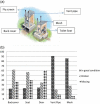Urine diversion dry toilets in eThekwini Municipality, South Africa: acceptance, use and maintenance through users' eyes
- PMID: 33384862
- PMCID: PMC7734370
- DOI: 10.2166/washdev.2017.079
Urine diversion dry toilets in eThekwini Municipality, South Africa: acceptance, use and maintenance through users' eyes
Abstract
This study was part of the VUNA project aimed to develop an affordable sanitation system that produces a valuable fertiliser, reduces pollution of water resources and promotes health. Urine diversion dry toilets (UDDTs) simplify the on-site hygienisation of faeces and allow for nutrient recovery from urine. Social acceptance is vital for the implementation of the UDDT, because sanitation is only effective if the system not only provides a well-designed toilet and effective waste management, but also offers users a facility that caters to their needs and is sensitive to their cultural lifestyle. This study used qualitative and quantitative methods to investigate acceptance, use and maintenance of UDDTs. Key findings indicate lower levels of acceptance of UDDTs among the elderly, who are accustomed to traditional pit toilets. The users aspire to own a flush toilet, perceived to be indicative of household wealth. A dominant concern was emptying the pit and the quality of the building material. Community interventions are required that will promote acceptance, understanding and encourage proper use and maintenance of the UDDT, and may need some technology modification. There is an urgent need for increased community participation to address users' perceptions, attitudes and behaviour concerning the UDDT.
Keywords: education; focus group discussions; qualitative; quantitative; re-use; sanitation.
© 2017 The Authors.
Figures
References
-
- Austin L. Duncker M., Matsebe L. C., Phasha G. N., Phasha M. C. & Cloete T. E.. 2005. Ecological Sanitation – Literature Review. University of Pretoria; CSIR. Report No. TT246/05. Water Research Commission.
-
- Baker S. M. & Ensink H. J.. 2012. Helminth transmission in simple pit latrines. Transactions of the Royal Society of Tropical Medicine and Hygiene 106 (11), 709–710. - PubMed
-
- Constitution of the Republic of South Africa: 1996sec. (24) (c.2). http://www.gov.za/sites/www.gov.za/files/images/a108-96. pdf (accessed 15 January 2016).
-
- Department of Water Affairs and Forestry (DWAF). 2006. Free State Province Sustainable Water Strategy: Water Master Plan. September 2006. Department of Water Affairs and Forestry, Pretoria, South Africa: http://www.dwaf.gov.za/dir_ws/ waterpolicy/vdFileLoad/file.asp (accessed 26 February 2016).
-
- Drangert J. O. 2004. Norms and Attitudes Towards Ecosan and Other Sanitation Systems. Report 2004-5 EcosanRes, Linköping University, Stockholm Environment Institute. http://esa.un.org/iys/docs/san_lib_docs/ESR5web%5B1% 5D.pdf (accessed 16 October 2015).
LinkOut - more resources
Full Text Sources


